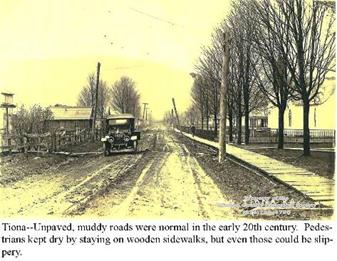
Mead Township

Mead Township was created in 1847 from portions of Sheffield, Kinzua, and Pleasant Townships. It is bounded on the north by the .jpg) Allegheny River. Its major settlements are Stoneham, Clarendon, North Clarendon, and Tiona. The township is named in honor of settler Darius Mead.
Allegheny River. Its major settlements are Stoneham, Clarendon, North Clarendon, and Tiona. The township is named in honor of settler Darius Mead.
The earliest European-American settlers in the area were the Morrison brothers of Jersey Shore, Pennsylvania, who arrived around 1800. The township, however, remained lightly populated throughout the first half of the nineteenth century. The first road running through the township, the Warren-Ridgeway Turnpike, did not open until 1833, and even then travel remained slow and difficult.
By the second half of the nineteenth century, the construction of railroads turned this once inaccessible “wilderness” into a very important industrial area. Mead Township was rich in many natural resources including oil, gas, and timber. The new railroad meant that products such as lumber, .jpg) oil, and leather could be shipped from Mead Township to markets throughout the world.
oil, and leather could be shipped from Mead Township to markets throughout the world.
Although it was, at first, passed by for other more valuable hardwoods, large stands of hemlock trees in the township provided the raw material for the leather tanning industry. Hemlock bark contains tannin, a chemical needed to turn animal hides into leather.
Once the railroad arrived, communities like Stoneham and Clarendon built tanneries that specialized in making shoe leather. Many of the communities in Mead Township have been known by .jpg) different names. Stoneham was settled in about 1839 and was originally named Rink Farm. It was later changed to Stoneham, named after settler Leroy Stoneham. One of the community's most important industries in the nineteenth century was Stoneham Tannery, which was begun in about 1868.
different names. Stoneham was settled in about 1839 and was originally named Rink Farm. It was later changed to Stoneham, named after settler Leroy Stoneham. One of the community's most important industries in the nineteenth century was Stoneham Tannery, which was begun in about 1868.
Tiona was first called Haltown, after settler Joseph Hall, who owned a sawmill in the area. The name was changed to Tiona when the Philadelphia & Erie Railroad arrived in 1864.
At first, Clarendon was called Pattonia for Thomas Patton, a contractor on the Philadelphia and Erie Railroad. It was later changed to Clarendon in honor of Thomas Clarendon of New York City, who was the partner of F.H. Rockwell. F.H. Rockwell started a tannery and sawmill at Clarendon in about 1879.
When oil was discovered in Clarendon and Tiona in 1882, many people rushed into the area. The population of Clarendon increased so dramatically as a result of the “oil operations and excitement” that it was made a borough in 1882. Although the amount of oil produced in the area .jpg) was relatively small, it was very high quality, and therefore, in demand by consumers as a lubricating oil.
was relatively small, it was very high quality, and therefore, in demand by consumers as a lubricating oil.
Today, the tanneries, refineries, and oil wells (once the economic life of Mead Township), have largely disappeared. However, there are still many signs of these industries along the roads and in the woods throughout the township.
Additional Resources:
- Story- The North Clarendon Fire
Courtesy of the Warren County Historical Society